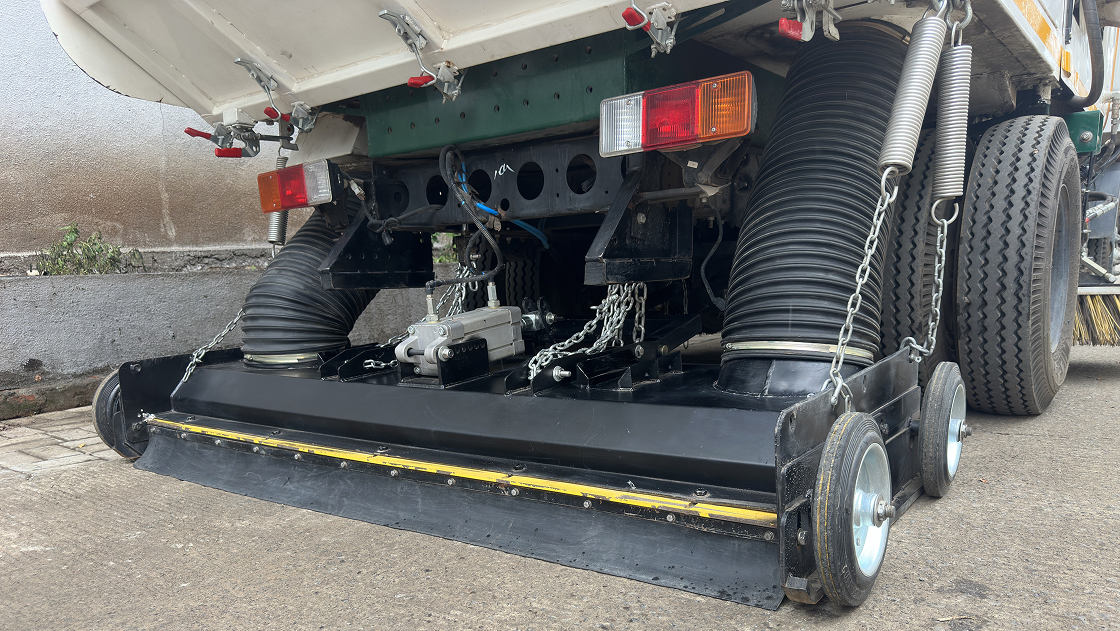VacuGuard: Pressure-stable sweeping with zero dust leaks
Introduction
In street sweepers, managing the pressure inside the pickup head is essential for two core outcomes: consistent suction and effective dust containment. A stable internal pressure ensures debris is lifted predictably across varying road conditions. Just as important, it allows the system to direct airflow in the right way. Without this, even a well-built machine can struggle to hold fine particles.
However, most regenerative sweepers rely solely on the main impeller to create suction and assume that’s enough to manage everything. There’s typically no dedicated mechanism to fine-tune pressure, offload excess air, or enforce inward airflow. The solutions they apply result in inconsistent pickup, premature strain on the system, and visible dust trailing, even when the sweeper appears to be working.
To overcome this, pressure control needs to be proactive, not reactive. Instead of relying on passive seals or overworking the impeller, the airflow itself should be stabilized using controlled relief. The system should maintain a gentle, consistent negative pressure inside the pickup chamber, not just to power suction, but to enforce clean containment. That’s what makes systems like dedicated negative pressure control a critical evolution.
Gaps in pressure control and dust sealing
1. Pressure stability and system load management
Most regenerative sweepers depend entirely on the impeller to create suction. There’s no separate system to regulate or fine-tune internal pressure. These machines assume that impeller speed alone will balance airflow, regardless of debris load, terrain changes, or hose bends. In an attempt to control dust, they often add physical barriers like skirts or gaskets or use high-pressure jets to patch weak zones. But these additions don’t regulate the actual air pressure, they just try to compensate for it after the fact.
Challenges:
Without internal pressure management, the airflow is unstable. Pressure can spike or collapse unpredictably, leading to uneven pickup. As debris load fluctuates, the impeller must work harder to maintain suction, which increases fuel use and wear. Since there’s no offloading mechanism, the system runs under strain, and still often leaks dust at pressure weak points. It becomes reactive, not adaptive, vulnerable to choke, overload, or dust blowback.
2. Inward airflow and dust containment
Challenges:
How VacuGuard stabilizes pressure & seals dust

1. Pressure stability and system load management
Stratus sweepers solve this with VacuGuard Negative Pressure Control. Instead of relying solely on the impeller, VacuGuard strategically bleeds off about 15% of the impeller’s discharge through auxiliary filters and vents it safely to atmosphere.. This controlled release creates a gentle, stable negative pressure inside the pickup head. That pressure stabilizes suction across different conditions and avoids overloading the impeller. Especially important when working in tandem with high-velocity systems like the Air Blaster pickup head.
Benefits:
A. Pressure stability for consistent pickup
By holding steady negative pressure, the system avoids suction spikes and collapses. Pickup remains predictable and consistent, even when debris varies or terrain shifts
B. Load management without strain
Because VacuGuard offloads excess pressure automatically, the impeller doesn’t need to work harder than necessary. This reduces fuel use, mechanical wear, and the risk of pressure-related failures. Thus delivering a more resilient, energy-efficient system.
2. Inward airflow and dust containment
Benefits:
A. Clean containment without complexity
B. Reliable dust control in real conditions
Because containment relies on stable negative pressure and not seals or components that degrade, Stratus keeps dust locked in even when skirts wear out or panels loosen. That means cleaner operation, fewer emissions, and no trailing dust clouds, even in the toughest sweep zones.
Most sweepers treat airflow as a byproduct of suction, not a design priority. But without stable pressure and intelligent containment, even high-powered machines fall short by straining their components and leaking dust despite good intentions. Stratus approaches it differently. With VacuGuard, pressure becomes a controlled resource, not just an output. It shapes how air moves, how dust is held, and how performance holds steady shift after shift. That’s not just better sweeping; it’s better system engineering.
